Grasshoppers are a major pest of cultivated crops and rangeland in the world's semi-arid regions. Areas receiving less than 750 mm of precipitation per year in the form of rain or snow are most susceptible. Traditionally drier areas like southwest Saskatchewan are more prone to recurring problems but serious grasshopper infestations can occur throughout the province.
Although the majority of damage has been to cereal grains, other crops can be seriously affected. In a more diversified agricultural landscape where cereals are often rotated with other crops such as canola, lentil and peas, grasshoppers continue to cause significant economic loss in Saskatchewan. Forage losses are seldom estimated but it has been shown in Alberta that even a moderate infestation of 10 grasshoppers/square metre can consume 16-60% of the available forage depending on the condition of the forage stand.
The type and extent of crop damage will depend upon the type of crop, how well the crop is growing, the number of grasshoppers present, and whether or not adequate cultural and chemical controls are used.
General Information About Grasshoppers
Grasshopper is the name given to a very large and diverse group of insects. All members of the group are characterized by chewing mouth parts, slender bodies, wings that fold lengthwise, large powerful hind legs for jumping and a gradual change in form and size as they develop.
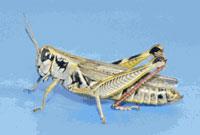
Photo by Sask. Agriculture
Grasshoppers are divided into two major subgroups,
- The short horned grasshoppers (Figure 1), and
- The long horned grasshoppers or katydids.
Short horned grasshoppers are responsible for most of the reported crop losses.
North America has more than 600 species of grasshoppers. In Saskatchewan there are more than 85 species. Fortunately, only a few species are considered to be of economic importance here. The species that are considered pests are economically important because under ideal food and weather conditions they multiply quickly and when present in large numbers they can cause severe crop damage.
The Important Species
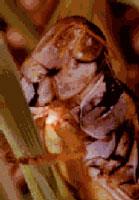
Photo by Bayer, Inc.
The short horned grasshoppers are divided into three types; (1) the spur-throated grasshoppers, (2) the band-winged grasshoppers, and (3) the slant-faced grasshoppers. Each type has distinguishing characteristics that make them relatively easy to identify. It is important that farmers recognize these characteristics if they are to control grasshoppers effectively.
(1) The Spur-Throated Grasshoppers
These grasshoppers are identified by the presence of a tubercle or knob between their front legs (Figure 2). Three of the most economically important species are members of this group, the migratory grasshopper, Packards grasshopper and the two-striped grasshopper.
The Migratory Grasshopper (Melanoplus sanguinipes)
Distinguishing characteristics
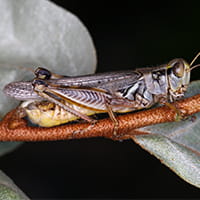
Photo by Dr. Dan Johnson,
University of Lethbridge
Adult grasshoppers are brownish to yellowish and approximately 23-28 mm (0.9 to 1.1 inches) long. Their hind legs are marked with a series of black bands. (Figure 3).
Habitat
The adult female lays her eggs mainly in stubble fields, but also in drift soil, weedy pastures, brome and alfalfa pastures, and roadside ditches. Summer fallow fields kept free of weeds are generally free of eggs even though they may have a substantial covering of plant residue.
Food Supply
Because it is a mixed feeder, the migratory grasshopper thrives in weedy grain fields, cultivated pastures and hay fields. Large numbers may be found in crops adjacent to stubble fields, especially if these fields are cultivated in late spring and trap strips have not been used. Grasshoppers hatching in crops seeded on stubble fields feed on growing seedlings and damage may go unnoticed until extensive leaf chewing has taken place. Extensive head clipping may occur in late summer when much of the leafy vegetation has been eaten or has matured.
Packard Grasshopper (Melanoplus packardii)
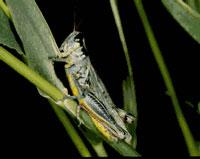
Photo by Sask. Agriculture
Distinguishing characteristics
Adult grasshoppers are gray to dark yellow and approximately 27-32 mm (1.1 to 1.3 inches) long. Two light coloured stripes extend from just behind the eyes to the posterior margin of the thorax. The forewings are uniformly grey and lack distinctive stripes. The last two segments of the hind legs are blue-green (Figure 4). When newly hatched these grasshoppers are pale green to yellow-brown, speckled with numerous small dark spots.
Habitat and Food Supply
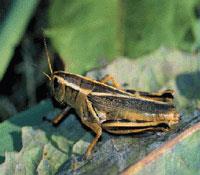
Photo by Dr. Dan Johnson,
University of Lethbridge
This grasshopper prefers light textured soils with scanty grass cover.
Two-Striped Grasshopper (Melanoplus bivittatus)
Distinguishing Characteristics
Adult grasshoppers are brownish or greenish with black or brown markings. They are approximately 26 – 40 mm (1.0 to 1.6 inches) in length. They have two pale stripes extending back from the eyes to the tip of the forewings. A solid longitudinal black stripe is evident on the hind legs (Figure 5). Immature grasshoppers are green to yellowish brown.
Habitat
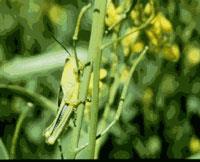
two-striped grasshopper.
Photo by Sask. Agriculture
This species is very common in the heavier textured soil zones. It is found along roadsides, in dried out marshes and in fields with crops.
Food Supply
It prefers lush foliage such as many of the weed species found associated with marshes and roadside ditches. It is often a pest of alfalfa and other crops. Occasionally, it may feed extensively on some of the trees commonly used as shelterbelts.
(2) The Band-Winged Grasshoppers
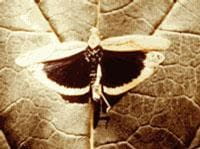
Photo by Sask. Agriculture
The main characteristic of band-winged grasshoppers is that the hind wings are usually brightly coloured. While in flight they may produce a cracking sound with their wings. The Carolina grasshopper with its black wings fringed with a pale border is probably the most conspicuous member of the group (Figure 6).
The most economically important species is:
The Clear-Winged Grasshopper (Camnula pellucida)
Distinguishing Characteristics
The adults are yellowish to brownish and approximately 21-32 mm (0.8 to 1.3 inches) in length. Their wings are clear but mottled with dark patches and they have two stripes beginning at the thorax and converging at the tip of the forewings (Figure 7).
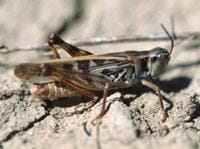
Photo by Dr. Dan Johnson,
University of Lethbridge
The newly hatched young are black with a distinctive white band encircling the thorax.
Habitat
The clear-winged grasshopper prefers to lay its eggs in sod on road allowances, overgrazed pastures and dried out marshy areas. Congregation of the adults during egg laying may result in as many as 10,000 or more eggs per square metre.
Food Supply
The clear-winged grasshopper is primarily a grass feeder that prefers cereal grains and some of the more succulent cultivated grasses. It seldom feeds on broad-leaved plants. Large pastures of native grasses are usually only infested around their margins where cultivated fields are close by.
(3) Slant-Faced Grasshoppers
This group of grasshoppers is not as abundant as the other types of grasshoppers. They often go unnoticed by the casual observer and they do not generally warrant control measures.
Distinguishing Characteristics
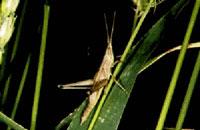
Photo by Sask. Agriculture
The slant-faced grasshoppers are characterized by a slanting to nearly horizontal face, their clear hind wings, conspicuous-sword-shaped or occasionally club-like antennae and broadly rounded thorax. An example of a typical member of this group is shown in Figure 8.
Habitat
The slant-faced grasshoppers are usually found along the borders of marshes, in wet meadows. However, some members of this group are also common in dry, grassy fields and pastures.
Food Supply
The slant-faced grasshoppers feed primarily on rangeland grasses and sedges. They are seldom associated with cultivated crops.
Grasshopper Life Cycle
The life cycle for all "economically important" grasshoppers in Saskatchewan is essentially the same. During the two weeks following mating, the female grasshopper hunts for an appropriate site to deposit her eggs. Once she selects a site she bores a hole with her abdomen and deposits a cluster of cream to orange coloured, slightly bent, cylindrical eggs. She then deposits a foamy secretion over them. This secretion hardens to form an egg pod.
The number of eggs per pod varies greatly, ranging from eight to one hundred and fifty. As a rule, grasshopper species that deposit few eggs per pod produce more pods than those which have many eggs per pod.
Under favourable environmental conditions a single female grasshopper may produce an egg pod every two to four days. Consequently, an average female grasshopper can produce more than 250 eggs in her lifetime.
Embryological development begins once the eggs are laid and continues until environmental conditions become unfavourable in the fall and will resume in the spring as the soil temperature rises. A temperature of 10 degrees Celsius is considered to be the minimum temperature at which embryo development will continue.
Newly hatched grasshoppers, or nymphs, are approximately 5 mm (0.2 of an inch) in length. In appearance these resemble adult grasshoppers, except for their size and the absence of wings. After hatching, the young grasshoppers begin feeding almost immediately on the surrounding plants. Although they are preferential feeders if choices are available, they cannot travel great distances at this stage and will consume most green vegetation in close proximity to the hatching sites.
Nymphal development consists of growth interrupted by periodic cuticle shedding (moults). When food is abundant and the weather is warm but not too wet, it will take approximately 35 to 50 days for the nymphs to go through the 5 (occasionally 6) nymphal stages before becoming a winged adult. Generally, adult females are slightly larger than males.
Annual Cycle
Although the life cycle of all grasshopper species is somewhat similar, the annual cycle may vary considerably. Variation between species depends on when the cycle begins and how long it lasts. For example, some grasshopper species over-winter as nymphs and a few over-winter as adults. Some species require two years to complete a life cycle. These species are usually responsible for the reports of grasshoppers in early spring and late fall. In Saskatchewan, no species has more than one generation per year. All of the economically important species in Saskatchewan begin their annual cycle in late summer or early fall of the preceding year, and over-winter as eggs.
Control of Grasshoppers
Effects of Weather
Temperature, rainfall and snowfall are all important in determining the severity of grasshopper infestations. A warm, extended fall will result in larger numbers of eggs being laid. The same conditions will also allow for greater embryo development within the eggs before colder temperatures suspend metabolic activity. This will tend to result in an earlier and more even hatch of young grasshoppers the following spring. Extremely dry conditions in the fall and spring will also limit embryo development within the eggs.
Winter temperatures can also have an effect on grasshopper populations. Very cold winter temperatures, with little snow cover can result in higher mortality as many grasshopper eggs will freeze. For some grasshopper species, prolonged exposure to subzero temperatures can kill up to 90 percent of the young inside the eggs. This may not be an important factor in most years as grasshoppers tend to lay their eggs in areas where snowfall will accumulate.
Spring temperatures will have only a minimal effect on the survival of the grasshoppers that hatch. Young grasshoppers are hardy enough to survive low, even below freezing spring temperatures, providing the cold temperatures do not persist for several days. The most important aspect of spring temperatures is its effect on the grasshopper development and plant growth. If the spring is hot, grasshoppers will hatch early and develop quickly. Cool spring temperatures will slow grasshopper development.
The relationship between temperature and rainfall affects the extent to which crops will be damaged by grasshoppers. Under dry, hot conditions a small grasshopper population may do as much damage as a large grasshopper population will under cool, wet conditions.
Rainfall may affect a localized grasshopper population to a lesser extent. Rainfall will only have an effect if a heavy downpour occurs immediately after an extensive hatch. A cool, wet June, however, will not seriously affect grasshopper populations.
The main effect of a warm humid summer is the increased potential of disease in grasshopper populations, which will help reduce densities the following year.
Natural Enemies

Agriculture
Next to weather, the grasshopper's natural enemies are the most important factor controlling grasshopper populations. In some localized areas they may even be a more important factor than the weather. Some of the grasshopper's enemies attack eggs in the soil. Others attack the nymphal and adult stages of the grasshopper.
Egg Predators
Among the most important of the egg predators are: bee flies, blister beetles, ground beetles, crickets and other insects. The adults of some of these insects, like the common field cricket feed directly on the eggs and may destroy up to 50% of the eggs in some areas.
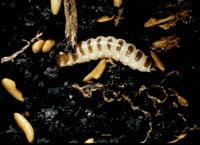
Others like the bee flies (Figure 9) and blister beetles deposit their eggs in the soil near grasshopper eggs.
When the larvae of egg predators hatch, they locate the egg pods, and feed directly upon the eggs. The larvae of a common blister beetle are shown, along with grasshopper eggs, in Figure 10. Epicauta spp. are important consumers of grasshopper eggs in western Canada. When bee flies and blister beetles are abundant they may destroy up to 80% of the eggs in a localized area.
Egg Parasites

A few other insects, such as the wasp (Scelio sp.), deposit their eggs within the newly laid grasshopper eggs. The young complete their development within the egg and will emerge instead of young grasshoppers in time to parasitize the eggs of the next generation of grasshoppers. They may destroy from 5-40% of the eggs.
Nymphal and Adult Predators
Spiders, some wasps and many birds may feed on grasshoppers and consume them in large numbers. However, their effect upon the total grasshopper population is not fully known.
Nymphal and Adult Parasites and Diseases
This group contains a large number of natural enemies including flesh flies, tachinid flies, muscoid flies, tangled vein flies, thread worms, fungi, microsporidians and numerous others.

Johnson, Agriculture and Agri-
Food Canada, Lethbridge
Most of the fly larvae either burrow into the grasshopper when they come into contact with it on the ground or they are deposited on or into the grasshopper's body. The fly maggot then feeds inside the grasshopper and eventually kills it as it leaves the body (Figure 11). This group of insects may have a cumulative parasitism of up to 60 per cent.
"Threadworms" are frequently found coiled inside grasshoppers. The "thread-worms" overwinter in soil and lay their eggs on the soil or on vegetation. Threadworms attack grasshoppers if the young larvae encounter a grasshopper or if grasshoppers eat threadworm eggs.

Sask. Agriculture
The fungus, Entomophthora grylli can control grasshoppers under warm, humid conditions. This fungus may occasionally reach epidemic proportions. The disease leaves the corpses of its victims clinging to the stems of plants (Figure 12).
The naturally occurring microsporidian parasite, Nosema locustae, has also been shown to have an effect on grasshopper populations. A grasshopper becomes infected if it ingests infected vegetation or an already diseased grasshopper. A grasshopper population infected with this organism may be reduced by as much as 60% in one year. It also appears that it affects grasshopper populations by reducing the number of eggs laid. Attempts to use this organism as a biological control agent has only shown limited success. A control product containing N. locustae spores for grasshopper suppression is now available.
Since most of the natural enemies of grasshoppers are already widespread it is unlikely that they could be used to prevent grasshopper outbreaks over extensive areas. Nevertheless natural enemies do play an important role in regulating and can contribute to reducing local grasshopper populations.
Cultural Control Methods
Of all the methods available for grasshopper control, cultural control methods are generally the least expensive. These methods do not require additional or special procedures. They merely involve good management strategies and timing of normal operations that are necessary in the production of a crop. By modifying the grasshoppers' environment at certain critical periods of its life cycle, a farmer may reduce numbers directly or at least their ability to reproduce.
Despite the advantages cultural control methods offer, many farmers are reluctant to use them since it is difficult to assess their effectiveness. Nevertheless, they can be effective, if they are implemented well in advance of any insect attack because they take time to work. Cultural control is a preventive approach to insect control.
The principal cultural methods used to control grasshoppers include early seeding of crops, crop rotation, tillage and trap strips.
Early Seeding
Crops should be seeded as early as possible. Older plants which are growing vigorously can withstand more feeding than younger plants which are not well established. Although early seeding will not entirely prevent crop damage, it will reduce the amount of damage to crops and will allow more time for the farmer to obtain and apply insecticides. Also, early-seeded crops mature early and migrating grasshoppers are less likely to be attracted to them as they are to lush young foliage.
Tillage and chemical fallow
Tillage or chemical fallow helps manage grasshopper populations primarily by eliminating the green plants on which young grasshoppers feed. It is advisable to complete early spring weed control to eliminate all green growth on fields before the grasshoppers have hatched. If no food is available for them to eat when they hatch, the young grasshoppers will starve.
Since female grasshoppers prefer firm, undisturbed soil in which to lay their eggs there may be some additional advantage from tillage. It is of little value, however, to undertake tillage for the sole purpose of physically destroying grasshopper eggs or exposing them to desiccation or predation by birds and other predators. Excessive tillage can reduce soil moisture levels and it increases the risk of soil erosion.
Trap Strips
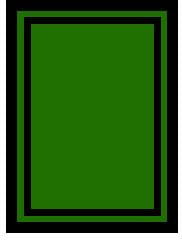
Note that trap strip methods of managing grasshopper populations will vary depending on the type of farming system whether it be conventional, reduced tillage or organic. If grasshoppers are present when weed control is initiated, it is probably impossible to achieve adequate control by simply eliminating all green plant material in a field. Once grasshoppers have fed and developed to the second stage of growth (2nd instar), they usually are mobile enough to move to adjacent crops when their food supply is exhausted. In these fields, trap strips can be used to collect grasshoppers into a relatively small area. Then it will be possible to control them quickly and economically using a minimum amount of insecticide.
To make strips cultivate a guard strip 10 m wide around the outside of a field. Leave a "green" trap strip of at least 10 m before resuming cultivation (Figure 13). Repeat the process as often as necessary to produce additional trap strips.
All green vegetation must be eliminated between the trap strips if they are to be effective. The guard strip should be adequate enough to ensure that grasshoppers will promptly move into the trap strips to feed. However, this trap strip does not have enough vegetation to feed a large grasshopper population for more than one or two days.
The effectiveness of trap strips can be improved considerably by seeding them to wheat or spring rye several weeks before tillage begins. Migration of young grasshoppers from the cultivated guard strips to the trap strips may take several days. Once the migration is complete, the trap strips and a 10 m strip of any adjacent crop should be treated with an insecticide. The highest application rate recommended for the insecticide used should be applied to ensure adequate control is achieved.
Before cultivating the trap strips, allow three days to assess the effectiveness of the insecticide. If adequate control is not achieved after three days, it may be necessary to treat the trap strip again. When grasshoppers have been eliminated from the trap strip, it should be possible to complete tillage without fear of displacing large numbers of grasshoppers into adjacent crops.
Economic Thresholds
The economic threshold or density of a pest at which control measures become economically viable, have been established in most cereal crops. It will depend on the stage of the insect, type of crop, crop stage, growing conditions, cost of control, and the current market value of the crop. The most serious economic damage due to grasshoppers will be while they are in the third to fifth nymphal stages. Since there are a number of factors to consider, the economic threshold can be variable. Considering these factors, the economic threshold in cereal crops ranges from 8 to 12 grasshoppers per square metre.
Feeding preference studies has shown that oats is an exception and is not a preferred food source for grasshoppers. If choices are available, grasshoppers will ignore oats in favour of a more desirable food source. Peas are another example of a non-preferred crop. In both these cases even if grasshoppers do feed on the crop damage is more limited and their biotic or reproductive potential is reduced. Therefore, they can be used as a guard strip around more preferred crops.
This strategy is a reverse of the trap strips previously considered. In this case the grasshoppers will tend to look for other food options rather than penetrate the guard strip into the main crop.
Lentil are more susceptible to grasshopper feeding than most other crops. Casual observation of grasshoppers in lentil would suggest this is not a preferred crop as they do not appear to feed on the foliage and the dense vegetative growth creates an unfavourable habitat for the insect.
Within the canopy a cool, moist micro-climate is created which can be detrimental to grasshoppers. However, grasshoppers prefer developing lentil pods above the canopy. They will even spread the flower parts to consume the early minute pods. This type of damage can result in delaying maturity as the plant tries to compensate by producing new pods.
Yield losses can result if entire pods are consumed but even moderate feeding on the pods will break the integrity of the pod, resulting in premature shattering and subsequent yield loss. If the feeding on the pod is less severe but still results in holes in the pod it increases the risk of disease and staining of the seeds which will result in a grade loss. Because of these factors the economic threshold in lentil is considered to be only 2 grasshoppers per square metre.
Once bolls have formed in flax, the economic threshold is two grasshoppers per square metre. Grasshoppers will cut the stem at the base of the boll resulting in a direct yield loss.
Because of the value and extent of canola grown in the province, an economic threshold for grasshoppers in this crop is being studied. Early observations suggest that B. napus varieties have more trouble compensating from grasshopper feeding than do B. rapa varieties. Brown mustard, B. juncea varieties appear to recover best out of these three plant species.
These are not highly preferred crops for some species of grasshoppers but early results suggest an economic threshold of about 14 grasshoppers per square metre.
